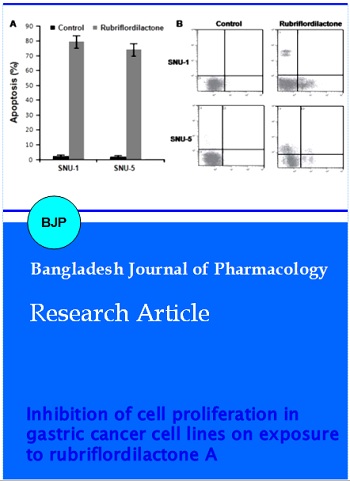Inhibition of cell proliferation in gastric cancer cell lines on exposure to rubriflordilactone A
DOI:
https://doi.org/10.3329/bjp.v11i1.23772Keywords:
Cell proliferation, Gastric cancer cell line, Rubriflordilactone AAbstract
The present study investigates the effect of rubriflordilactone A on the viability and its underlying mechanism in gastric cancer cell lines (SNU-1 and SNU-5) and normal gastric epithelial cell line (GES?1). Incubation of the gastric cancer and non cancer cell lines in acidic media led to reduction in the viability of the non cancer cells without any effect on cancer cells. Apoptosis in SNU-1 and SNU-5 cells was induced on exposure to rubriflordilactone A after 48 hours compared to the control cells (p<0.01). The percentage of apoptosis in SNU-1 and SNU-5 cells on exposure to rubriflordilactone A was 79.3 ± 4.7 and 74.0 ± 5.1, respectively after 48 hours. Exposure of SNU-1 and SNU-5 cancer cell lines to rubriflordilactone A at a concentration of 10 ?M in media with acidic pH decreased phosphorylation of ERK ½. The similar reduction was caused by ERK 1/2 phosphorylation inhibition, PD98059. Thus rubriflordilactone A reduces viability of gastric cancer cell lines by inducing apoptosis through the reduction of ERK 1/2 phosphorylation.
Downloads
1219
838 Read
709

Published
How to Cite
Issue
Section
License
Authors who publish with this journal agree to the following terms:
- Authors retain copyright and grant the journal right of first publication with the work simultaneously licensed under a Creative Commons Attribution License that allows others to share the work with an acknowledgement of the work's authorship and initial publication in this journal.
- Authors are able to enter into separate, additional contractual arrangements for the non-exclusive distribution of the journal's published version of the work (e.g., post it to an institutional repository or publish it in a book), with an acknowledgement of its initial publication in this journal.
- Authors are permitted and encouraged to post their work online (e.g., in institutional repositories or on their website) prior to and during the submission process, as it can lead to productive exchanges, as well as earlier and greater citation of published work (See The Effect of Open Access).
